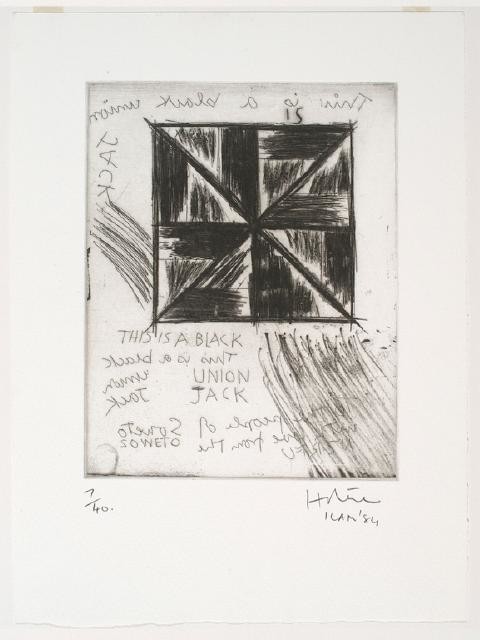Painting in New Zealand 1970
| 1974 Commonwealth games logo |
Ralph Hotere
Between 1979 and 1983 Ralph Hotere produced a large number of studies and paintings that took the Union Jack, drained it of it's colour, and squared it up—in doing so referencing the much-celebrated logo of the 1974 Commonwealth Games (Galloway, 2015) in Christchurch. Underneath this motif he stenciled in matter-of-fact capitals: THIS IS A BLACK UNION JACK. It speaks to the idea of the changing nature of how we saw ourselves as a country at the time—not as the colony we were, but still struggling with the notion of a national identity. Here was a black Union Jack—the shape reminiscent of where we were coming from, but leached of it's colour and in the process now representing our own national colours. It could also be seen as a strikingly simple statement of ownership—alluding to Maori union with the land, and the ongoing debate around race relations in this country. Which brings us to the second reading; this was a message. Specifically, a message aimed at the NZRFU, it's All Blacks, and a government who insisted on playing Rugby with apartheid-era South Africa. Hotere's Black Union series was a collection of protest paintings that playfully juxtaposed the visual harmony of the Union Jack symbol against the disharmony of the political environment he found himself in as a New Zealander. Hotere was using that exact moment in time—one of the most tumultuous in our young history as a nation—to position the Springbok tour within a larger picture of the residual racism and Empirical hangover that continued to have sway over how we saw ourselves as a country, and how that view of who we were in turn feed individual actions and collective attitudes. (Galloway, 2015)
Phillip Clairmont
 Clairmont was born in 1949 and took his own life in 1984. ("Philip Clairmont: the anachronism of visionary perception", 1976) He attended Ilam School of Fine Art and graduated with honours in painting. While studying in Canterbury, Clairmont was taught by a diverse group of painters, including Don Peebles, Doris Lusk and Rudolf Gopas. Fellow artists Tony Fomison and Philip Trusttum reinforced the expressionistic tendencies Clairmont had developed before he started art school.
Clairmont was born in 1949 and took his own life in 1984. ("Philip Clairmont: the anachronism of visionary perception", 1976) He attended Ilam School of Fine Art and graduated with honours in painting. While studying in Canterbury, Clairmont was taught by a diverse group of painters, including Don Peebles, Doris Lusk and Rudolf Gopas. Fellow artists Tony Fomison and Philip Trusttum reinforced the expressionistic tendencies Clairmont had developed before he started art school.
Clairmont typically drew his subject matter from his domestic surroundings. Everyday objects assume a life of their own and take on anthropomorphic, often menacing, qualities. Expressive, gestural brushwork and sharp angular forms add to the tension created in this work.
Clairmont was influenced by German expressionism, which used sharp, angular treatment of form, elongated figures, and bright, discordant colour to create feelings of alienation and anxiety in the viewer. Clairmont was also influenced by the grotesque, threatening images of the Anglo-Irish painter Frances Bacon – and by his commitment to painting as a way of life. ("The scarred couch, the Auckland experience by Philip Clairmont | NZHistory, New Zealand history online", 2017)
References
Galloway, M. (2015). Black Union. Otago Daily Times, p. 1.
Philip Clairmont. (2019). Retrieved from https://www.aucklandartgallery.com/explore-art-and-ideas/artist/903/philip-clairmont
Philip Clairmont: the anachronism of visionary perception. (1976). Art New Zealand, (1).
The scarred couch, the Auckland experience by Philip Clairmont | NZHistory, New Zealand history online. (2017). Retrieved from https://nzhistory.govt.nz/media/photo/scarred-couch-auckland-experience-philip-clairmont


Comments
Post a Comment